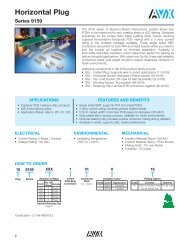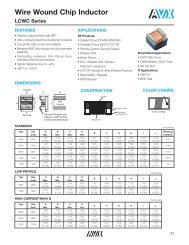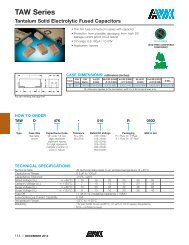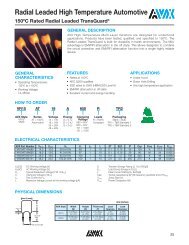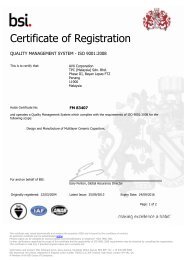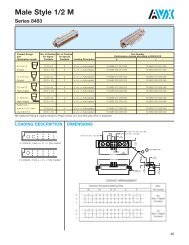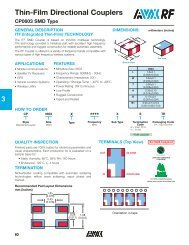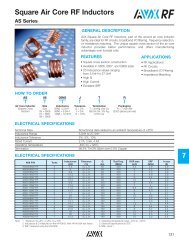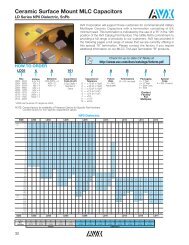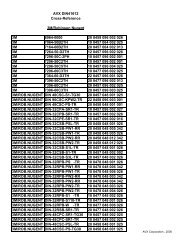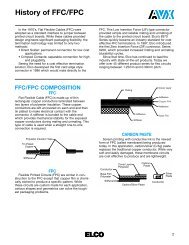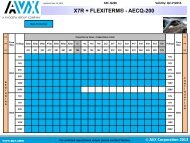CV Capability Guide - AVX
CV Capability Guide - AVX
CV Capability Guide - AVX
Create successful ePaper yourself
Turn your PDF publications into a flip-book with our unique Google optimized e-Paper software.
Medium Power Film CapacitorsFFV3 (RoHS Compliant)DC FILTERINGThe series uses a non-impregnated metallized polypropylene orpolyester dielectric, with the controlled self-healing process,specially treated to have a very high dielectric strength in operatingconditions up to 105°C.The FFV3 has been designed for printed circuit board mounting.BGeneral tolerance: ±0.5 (±0.020)Dimensions: millimeters (inches)1.2 (0.048) BA1 230 (1.181)123 434Check for up-to-date <strong>CV</strong> Tables athttp://www.avx.com/docs/catalogs/filmcaps.pdfAPPLICATIONSThe FFV3 capacitors are particularly designed for DC filtering,low reactive power.STANDARDSIEC 61071-1, IEC 61071-2: Power electronic capacitorsIEC 60384-16: Fixed metallized polypropylenefilm dielectric DC capacitorsIEC 60384-16-1: Fixed metallized polypropylenefilm dielectric DC capacitorsAssessment level EIEC 60384-17: Fixed metallized polypropylenefilm dielectric AC and pulsecapacitorsIEC 60384-17-1: Fixed metallized polypropylenefilm dielectric AC and pulsecapacitorsAssessment level EIEC 60384-2: Fixed metallized polyester capacitorsLIFETIME EXPECTANCYOne unique feature of this technology (as opposed to electrolytics)is how the capacitor reacts at the end of its lifetime. Unlikealuminum, electrolytics film capacitors do not have a catastrophicfailure mode. Film capacitors simply experience aparametric loss of capacitance of about 2%, with no risk ofshort circuit.Please note that this is theoretical, however, as the capacitorcontinues to be functional even after this 2% decrease.PACKAGING MATERIALSelf-extinguishing plastic case (V0 = in accordance with UL 94)filled thermosetting resin.Self-extinguishing thermosetting resin (V0 = in accordance with UL94; I3F2 = in accordance with NF F 16-101).25 (0.984)16 (0.630)1.2 (0.047)±0.1 (0.004)40 (1.575)40 (1.575)0.6 (0.024) APlastic Case0.8 (0.032)±0.1 (0.004)4.5 (0.178)±1 (0.040)HOT SPOT CALCULATIONSee Hot Spot Temperature, page 3.36 (1.418)θ hot spot = θ ambient + (P d + P t ) x (R th + 7.4)θ hot spot = θ case + (P d + P t ) x R thwith P d (Dielectric losses) = Q x tgδ 0⇒ [ 1 ⁄2 x C n x (V peak to peak ) 2 x f ] x tgδ 0tgδ 0 (tan delta)For polypropylene, tgδ 0 = 2 x 10 -4 for frequencies upto 1MHz and is independent of temperatures. Forpolyester, tgδ 0 values are shown in graph 4 on page3.P t (Thermal losses) = R s x (I rms ) 2where C n in Farad I rms in Ampere f in HertzV in Volt R s in Ohm θ in °CR th in °C/W R th : R th case/hot spot in °C/W164 | www.avx.com



